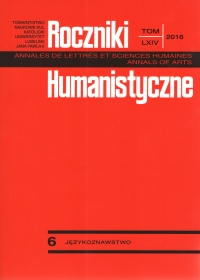Palikot as a linguistic problem
Abstract
The surname Palikot is a highly polysemous personal name. At least ten related etymologies can be identified. Palikot that is someone: 1. who kills(ed) cats with fire, burns(t) them; 2. whoset(s) fire to animals (particularly cats) and objects; 3. shot(s) hares, 4.who happens(ed) to shot a cat instead of a hare; 5. who burns(t) the remnants after ploughing the field; 6. who is/was attracted by female bosom; 7. whose cat caught fire in his house; 8. who is/was mentally unstable like an agitated cat, and allegedly having to do with unclear forces; 9. who is/was obsessed with passion and lust like a cat; 10. who easily loses (lost) temper, behaving like a type of canon. The ambiguity in question is, first and foremost, owing to two potential ways of analysing the structure of the compound word Palikot. It can either be interpreted as an exocentric compound with the deverbal head pali- [burn] and the nominal argument -kot[cat], or as an endocentric compound with the reversed roles of the components. Moreover, the homonymy in question is also caused by the semantic ambiguity of both compound components, where the verb burn and the noun cat can be used in their basic or metaphorical/metonymic meanings. Taking into account the fact formally speaking, the first two etymologies display the best match between the surface and the deep strucure of the compound, they constitute the best interpretative choices. The violent hooligan practice of setting fire to cats and letting them run – rather than burning them – speaks in favour of the second etymology in particular.
Copyright (c) 2016 Roczniki Humanistyczne

This work is licensed under a Creative Commons Attribution-NonCommercial-NoDerivatives 4.0 International License.





